I know I said I would have three techniques for you to try, but I only have two. I’ve opted not to use my New Idea (cast on 20, divide them alternating between two needles, go on from there) because the stitches are loose unless you twist them as you knit them. The twisted stitches look interesting, and I might use this idea for something else, but it won’t work here.
I’ve got a toe-up cast on and my favorite knitting trick for you to try. If you want to participate, please try both and then leave a comment that tells me:
a) Which written instructions are the easiest to follow.
b) Which method is the easiest to accomplish.
c) Which technique was more fun.
d) Which you think is better-looking or anything else you discovered or thought of that might be helpful.
To participate, you’ll need a set of four double pointed needles and some scrap yarn.
I estimate that this little exercise will take you less than 20 minutes. If you spend much more time than that figuring these out, I need to try something different. Every opinion is valuable and I want to hear them all! However, if you’ve never tried either of these techniques before, yay! I am especially interested in fresh eyes and fingers. I’m not sure why I am reluctant to tell you what toy part we’re working on, but I am going to go with my gut here and keep it a secret.
Everyone who leaves a participating comment will be entered to win a drawing for my favorite hands-free (thus knitting-friendly) treats:
One dozen lollipops from This Charming Candy!
You pick the flavor, I’ll place the order and have them sent straight to your door or P.O. Box. I strongly recommend the salted caramel, but no pressure. Make sure you leave a valid email with your comment so I can get in touch with you!
Are you ready to get started? Let’s begin with a cast-on commonly used by toe-up sock knitters. It’s not Judy’s Magic Cast-On. While this one was really clever and looked good, it took me way too long to ‘get’. Completely worth it if I planned to make several pairs of toe-up socks, but not for this project. I got the Figure 8 on the first try so that’s what we’re testing.
Test Piece One: Figure 8 Cast-On on DPNs
Grab yourself a couple double pointed needles and hold them side-by-side in your left hand. I found it helpful to tie the tail of the yarn to one needle to give you an anchor to start with. If you choose to do this, count that as one of your stitches.
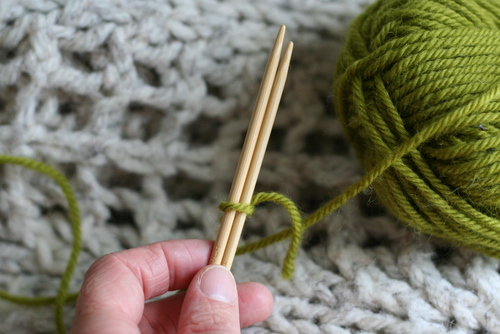
Pretend that is tied to just one needle.
Begin to wind your yarn around the two needles in a Figure 8.
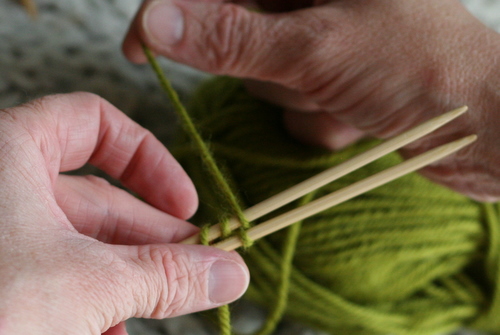
Wrap up around the top needle…
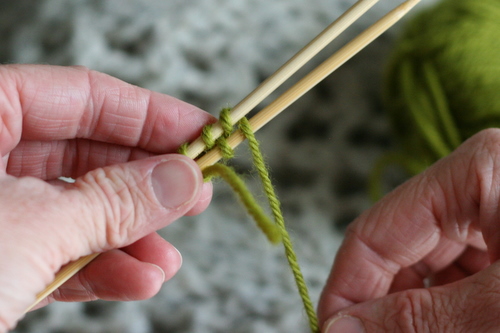
…between the needles and down around the bottom one.
Keep going until you have 10 loops around each needle. If you spread out the stitches, they should alternate like footprints.
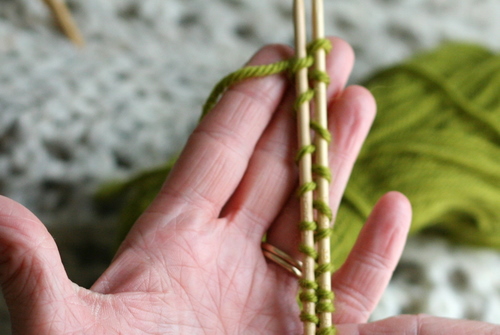
Check to make sure that the yarn is wrapped back and forth between the needles.
Grab another double pointed needle and knit all the stitches on Needle 1. Note: One of these needles will have the stitches on ‘backwards.’ When you identify that needle, just be sure to knit those stitches through the back loop. I haven’t done enough research to figure out if this is the second needle every time or if it depends on which needle you start with. If you’ve got some insight, please share?
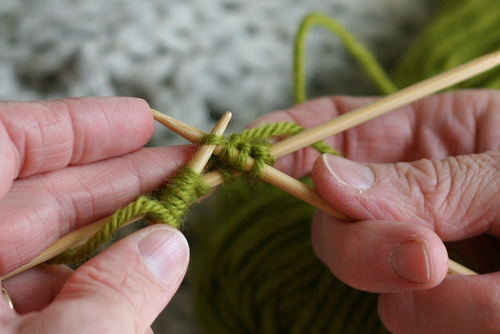
My first needle was right.
Knit the stitches on Needle 2.
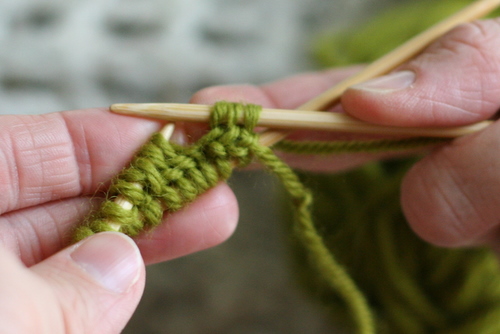
These were backwards for me.
I found that dividing the stitches was easier if I knit another round with the stitches on two needles. Please tell me if your mileage varies.
Knit the first 6 stitches from Needle 1. With a fresh needle, knit the last 4 stitches from Needle 1 and continue across the gap (turn the corner) knitting the first 4 stitches from Needle 2 onto the same needle. With a fresh needle, knit the last six stitches from Needle 2. Your stitches will now be divided onto three double pointed needles as 6-8-6. Continue to work in the round as expected. Rounds begin and on the side.
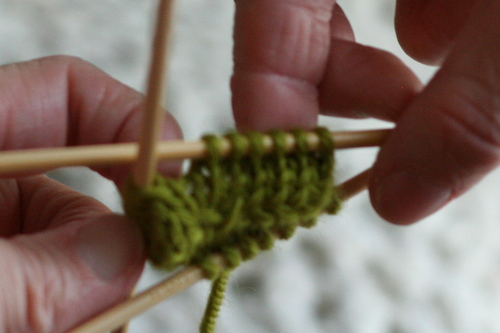
Really blurry, but you can see how the flat end looks.
To finish the sample piece, knit 4 rounds evenly. Break the yarn and run the tail through the live stitches so they don’t unravel. There is no need to draw them up or secure the tail.
Test Piece Two: Emily’s Favorite Trick for a Flat Bottom
Using two double pointed needles as straight needles, cast on 20 stitches.
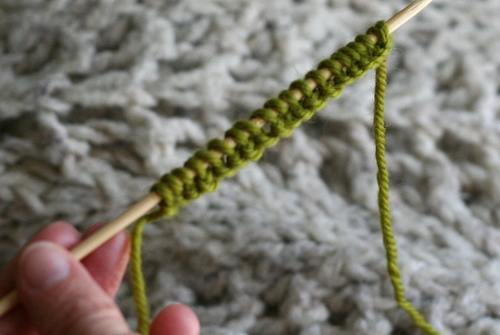
With me so far?
Next: *K1, S1 repeat from * to end of row.
Repeat this row seven more times.
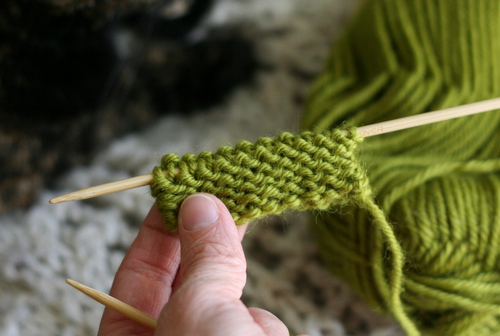
Looks like it is wrong side out? That’s because it is wrong side out.
Now be brave. Take your piece.
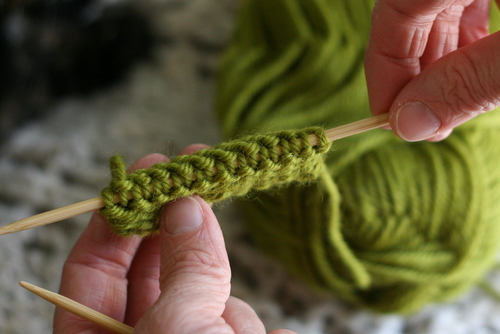
Deep breath…
Pull out the needle. Don’t panic. You’ve created a little pocket with all that slipping and knitting. Gently pull the sides apart to open it up.
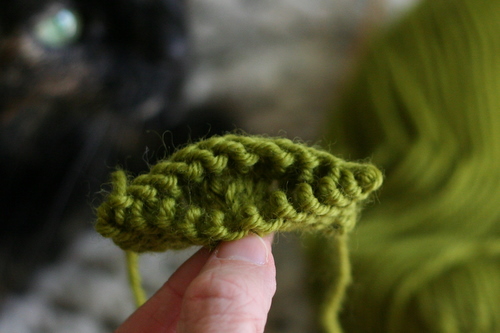
If you’ve done it right, it will open right up.
Now carefully slide one double pointed needle through the 10 stitches on the top edge of the pocket.
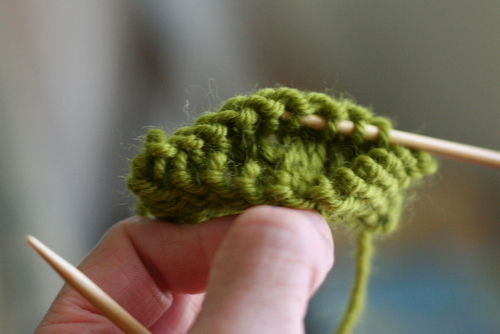
Just scoop them all back up.
And then do the same thing with another double pointed needle and the 10 stitches opposite row.
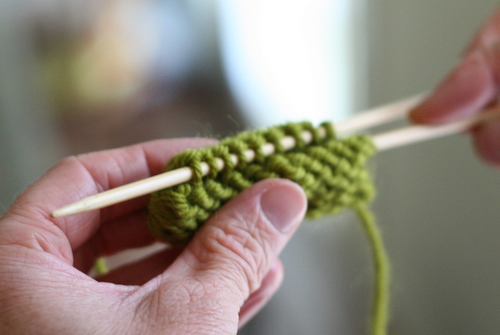
You’ll feel better once all the stitches are back on the needles.
Now flip the piece inside out so that the smooth side of the stockinette is on the outside.
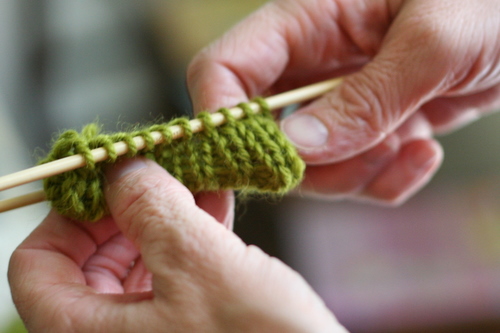
Surprise!
To divide the stitches onto three DPNs: Knit six stitches. With a fresh needle, knit the last 4 stitches from Needle 1 and continue across the gap (turn the corner) knitting the first 4 stitches from Needle 2 onto the same needle. With a fresh needle, knit the last six stitches from Needle 2. Your stitches will now be divided onto three double pointed needles as 6-8-6. Continue to work in the round as expected. Rounds begin and on the side.
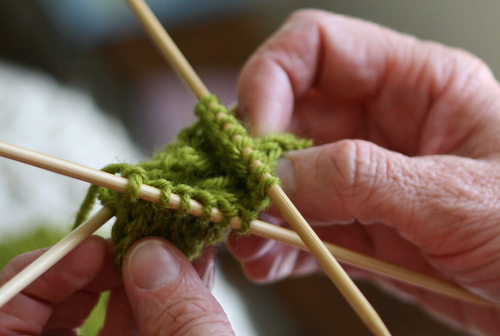
There you go!
It is very likely that your gauge will change from the *K1, S1* portion of the knitting to when you switch to stockinette in the round. That is just fine for my purposes and might be preferable! To finish the sample piece, knit 1 round evenly. Break the yarn and run the tail through the live stitches so they don’t unravel. There is no need to draw them up or secure the tail.
You’re all finished! I’ll leave comments on this post open through Friday evening. If you’ve got free time like I’ve got free time, it will take you that long to get around to it.
Thanks very much for your time and patience!
WAIT! Beth suggested the Middle Eastern Cast-On! It’s easy peasy and the stitches aren’t ever backwards! If you’ve got another minute, would you go take a look?
